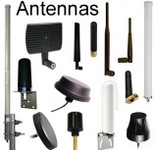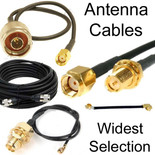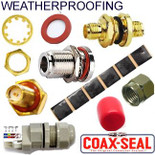Antennas, Antenna Cables, Wireless Products: Technical Articles
Operate 2 Antennas from One Radio: Use a "Power Divider" or "Antenna Combiner" - NOT a T-adapter
Power Divider / Antenna Combiner:
Do not use a "T connection" to get one AP to service two antennas: This causes many problems, further described below. By "T connection," we mean T-adapter to combine two antennas onto the same antenna cable.
A "T" is the incorrect way to split to antennas or transmitters. It results in a 2:1 impedance mismatch. That in turn, will cause signal degradation and probably equipment failure. You must use a "power divider" or "antenna combiner" device to operate two antennas from one transmitter. These devices are not expensive, and they are necessary. There are many variations on the concept, but the end result is that a 50 ohm load is presented to the transmitter, and each antenna "sees" a 50 ohm transmitter as well.
The common TV "splitter" does work for exactly the reasons above. At 2.4 GHz, our requirements are more stringent than at TV frequencies, but the approach is exactly the same.
The Difference Between a Power Divider and a T-adapter
Design and Purpose:
- Power Divider/Antenna Combiner: Specifically designed for connecting multiple antennas to a single radio, these devices distribute power evenly among all antennas while ensuring that the impedance of the system is maintained. They ensure minimal signal loss, reflection, or interference.
- T-adapter: Originally designed to split signals for purposes other than connecting multiple antennas to radios, T-adapters do not guarantee equal distribution of power, nor do they ensure impedance matching. This can result in signal degradation.
Reflection and Signal Loss:
- Power Divider/Antenna Combiner: These devices are designed to minimize reflections which can cause standing waves, a phenomenon that results in signal loss. The minimized reflection ensures a clear and strong signal between the radio and antennas.
- T-adapter: With a T-adapter, there's a higher risk of signal reflection. This can reduce the effectiveness of the antennas and can even cause potential damage to the radio due to the reflected power.
Impedance Matching:
- Power Divider/Antenna Combiner: Ensuring that the impedance of the entire system remains consistent is vital for effective transmission and reception. Power dividers and antenna combiners are designed to maintain a 50-ohm (or whatever the standard might be) impedance across the system.
- T-adapter: T-adapters do not ensure impedance matching. Mismatched impedance can lead to poor performance and signal loss.
Isolation Between Antennas:
- Power Divider/Antenna Combiner: One of the main features of these devices is to provide isolation between the connected antennas. This ensures that signals from one antenna do not interfere with those from another.
- T-adapter: Without the inherent design for isolation, T-adapters can lead to inter-antenna interference, impacting overall performance.
So, Why Not Use a T-adapter?
The use of a T-adapter, though seemingly straightforward, can lead to multiple issues:
- Signal Degradation: As mentioned above, the lack of impedance matching and increased reflections can lead to a degraded signal, reducing the effectiveness of the communication system.
- Potential Damage: The reflected power, due to impedance mismatch, can flow back into the radio, causing potential damage to its components.
- Reduced Performance: Without proper isolation, the antennas might interfere with each other, reducing overall system performance.
Conclusion:
When aiming to operate multiple antennas from a single radio, the choice of equipment can make all the difference. While a T-adapter might seem like an easy and cost-effective solution, it is not suitable for this purpose. Instead, investing in a power divider or an antenna combiner will ensure system integrity, longevity, and optimal performance. Proper tools for the job always yield better results.








